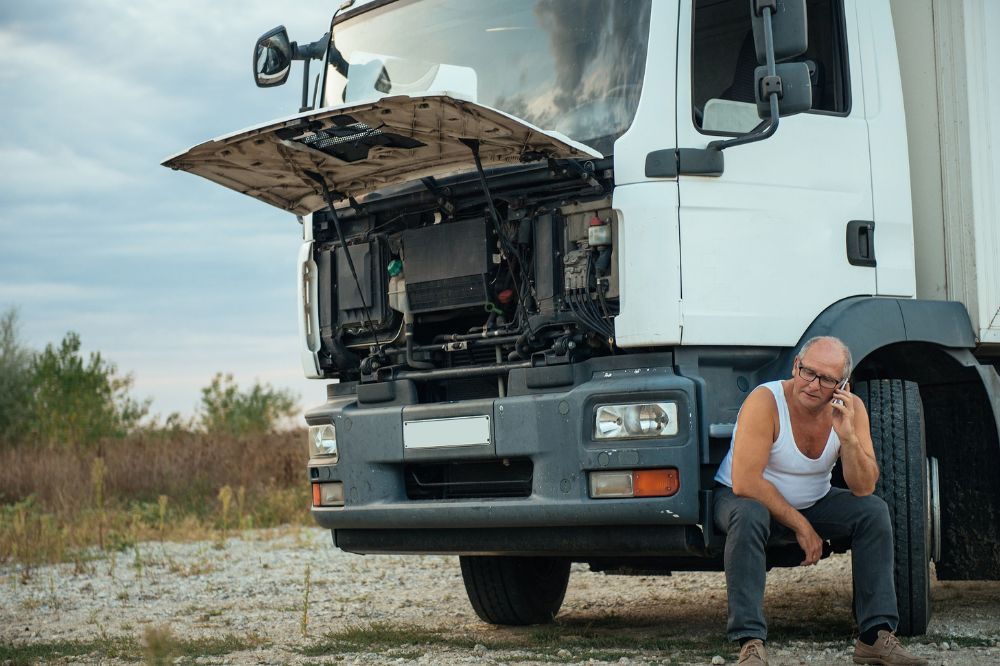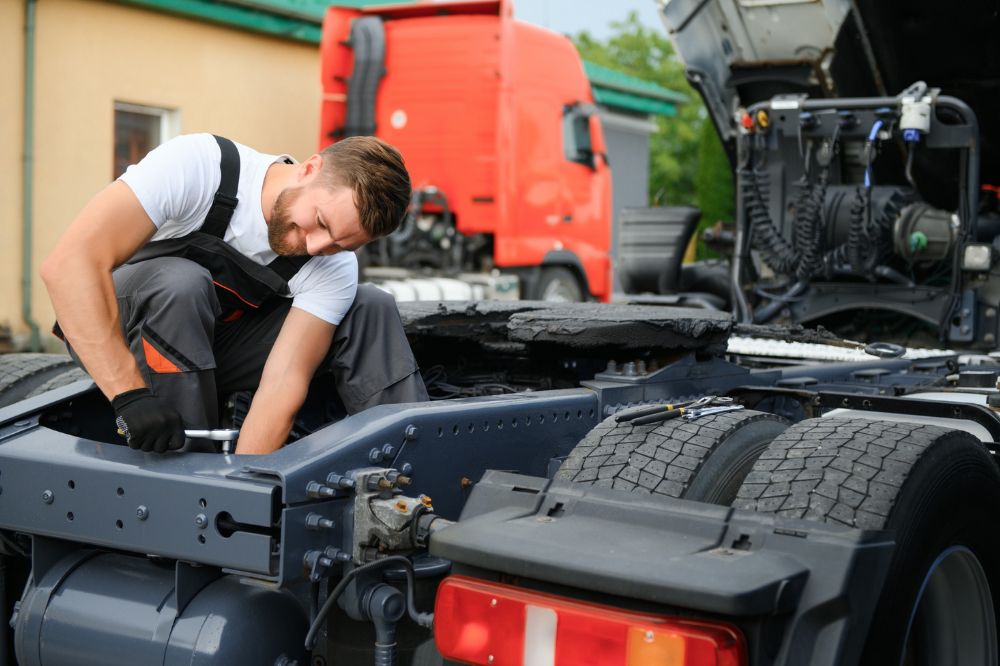Semi-truck breakdowns are a common occurrence in the trucking industry. Engine failure, oil leaks, electrical, and tire issues can occur anytime, leading to unexpected breakdowns. This can be dangerous, especially if it happens on a busy highway.
To keep yourself and other road users safe when your semi-truck malfunctions, there are a few steps you should take. This quick guide covers how to handle a big rig breakdown by the roadside safely.
Truck Driver Tips For Handling a Big Rig Breakdown
Keep the following tips in mind to properly deal with a truck breakdown:
Be Prepared For the Unexpected
To minimize the impact of potential a big rig breakdown while covering long distances, it’s essential to prepare ahead. Before each trip, identify safe stopping points and nearby repair facilities along your planned routes. Note down their names and contact details, and adjust your GPS accordingly, especially if you’re an owner-operator responsible for your truck’s maintenance.
Being proactive allows you to expedite repairs rather than being stranded on the road waiting for assistance.
If you’re a company driver, familiarize yourself with your company’s procedures for handling breakdowns and know which towing services they use for roadside help. Keep your dispatcher’s after-hours contact handy to avoid being stranded in case of a breakdown outside regular working hours.
Keep Calm
Semi-truck breakdowns can occur unexpectedly, often in challenging conditions like severe weather or unfamiliar locations. In such situations, it’s crucial to remain calm to make safe decisions. Panic can escalate a minor breakdown into a serious incident, so staying composed is essential for ensuring everyone’s safety.

Pull Over For Safety
Most times, professional drivers feel when their semi-truck is about to fail. When the signs of mechanical failure start, ease off the road for safety. Defective equipment is one of the top causes of truck crashes.
Drive your truck to the next exit and off the main road before stopping, if possible. If you can’t and your semi-truck breaks down on the shoulder of a highway, stay vigilant and watch out for speeding traffic to avoid potential trouble.
Ensure That Other Drivers Are Aware Of The Breakdown
A stalled semi-truck on the road becomes a hazard for other motorists, especially considering the prevalence of inattentive driving. The risk of an inattentive driver colliding with your stalled truck is significant and could lead to catastrophic consequences, resulting in fatal accidents.
As a professional driver, it’s imperative to signal clearly when your semi-truck is incapacitated and unable to move. This proactive measure helps alert other drivers to take necessary precautions to steer clear of your vehicle, mitigating the risk of accidents.
To indicate that you’re experiencing a breakdown, do the following:
Turn on Hazard Lights
Inattentive drivers can quickly spot the flashing lights on your semi-truck, signaling that it’s experiencing issues and likely stationary. Upon seeing this, they’ll reduce speed, maintain a safe distance, and steer clear of your vicinity.
Put Out Flares and Triangles
Flares and triangles are warning signs informing other truckers and road users to be aware of a stationary vehicle ahead. Place these behind your truck at 50’-100’-50’ intervals once you’re sure it’s safe to get out of the semi-truck.

Tilt Open the Hood
Tilting open the hood is another effective way to tell other road users that your semi-truck has broken down and might take a while to move.
Call for Help
After taking the necessary steps to ensure everyone is safe, try assessing the problem to see if it requires simple repairs you can work on yourself or whether you’ll need to contact repair services. Common truck breakdowns are because of faulty emission equipment or faulty sending units. These require shop repair as fixing them can be tricky to DIY.
Call the nearby repair facility for assistance if you’re an independent trucker. Doing this should be straightforward if you prepared yourself well. Otherwise, you’ll have to search online to identify the best repair shops in proximity that you can work with.
If you’re a company truck driver, it’s crucial to follow the correct procedure. First, call your dispatcher to inform them about your situation before contacting the company shop foreman. They’ll advise you on the steps you should take.
The company shop foreman might even contact the company’s repair services on your behalf. Also, remember to keep your dispatcher updated throughout the repair process so they can keep the customer informed.
Truck Breakdowns – Emergency Toolkit
Sometimes break downs are caused by simple mechanical issues you can fix yourself. It’s always a good idea to carry supplies to help you handle simple repairs when the situation permits. So you can avoid long waiting and repair times.
A few basic supplies you should carry include:
- Standard hand tools, including screwdrivers, nuts, and bolts
- Flashlights to improve your nighttime visuals
- Duct tape
- Extra oil and coolant
- Tire depth and air pressure gauge
Check out our other guide on semi-truck driver toolkit essentials for more handy supplies to include in your emergency toolkit.

Reduce Your Chances of Future Breakdowns
Even though semi-truck breakdowns are inevitable in trucking, you can minimize their odds of occurrence. The best to do this is through preventative maintenance. Perform regular inspections pre-, on-route, and post-trips to ensure your semi-truck is always in tip-top shape.
During a pre-trip inspection, check the engine compartment. Specifically, look at:
- The belts and hoses’ overall condition
- The engine bay for an unusual buildup of oil, dirt, grease, and other materials
- Signs of leaking fluids inside the engine compartment or underneath the couch
- The alternator to ensure all battery cables are secured, i.e., not chaffed or too loose to rub against other components
On an on-route inspection, focus on:
- The condition of your tires and wheels
- Checking for leaks and any unusual odors, particularly at the back of the couch close to the engine area
If you notice anything out-of-order, have it checked out at the truck stop you’re in, or call your company for further instructions.
As for post-trip checks, pay attention to the following components to ensure they’re in optimum working condition:
- Brakes (service and parking brakes)
- Steering mechanism
- Tires
- Wheels and rims
- Lighting devices and reflectors
- Emergency equipment
Final Thoughts
As a trucker, it helps to know how to handle a big rig breakdown on the road for your safety and the safety of other road users. All the tips we’ve discussed will help you with this, but the most crucial tip is to stay calm.
Remember that regular maintenance reduces your chances of experiencing breakdowns. So perform your routine checks diligently and ensure all issues you identify during your routine inspections get resolved in time.
If you need help financing your semi-truck repairs, get in touch with us. We offer affordable semi-truck repair loans and can tailor our loan packages to your situation to help you minimize downtime and keep moving.



